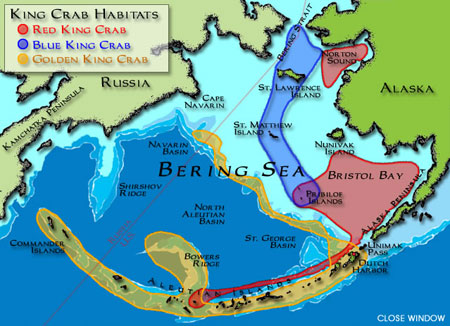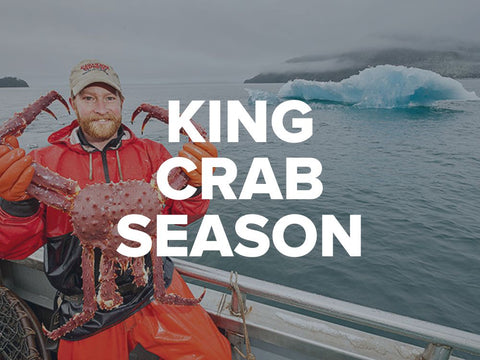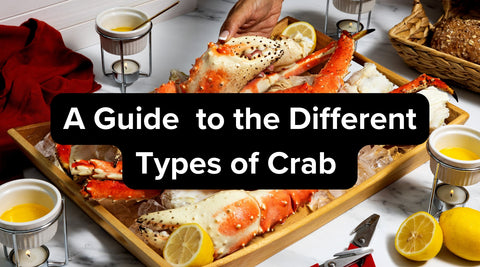King Crab season is about to start ramping up, which is obviously exciting for many reasons for all of us true King Crab lovers out here. The King Crab season can span anywhere in the cold winter months starting in October and ending roughly in January every single year. Nearly all of the King Crab on the planet come from very specific regions: Bristol Bay in Alaska, the Bering Sea located in between Alaska and Russia, and from a growing, invasive population in the Barents Sea and Norwegian Sea (placed by the Russians in 1965 to promote a western fishery).
Yes, it’s true, last year’s Red King Crab fishing season in Alaska was canceled due to a drastic drop in stock levels, but that still doesn’t stop the demand for this beautiful, prized and delicious sea creature. And also, don’t forget there are also other species of King Crab, so there are other options and means of getting the desired King Crab one way or another. Here are how the fishing seasons break down:
“Golden King Crab can usually be caught throughout the year from the middle of February to the middle of June, while Red Alaskan King Crab season opens for only short windows in the fall from November through January.
In the Arctic-Yukon-Kuskokwim area, the Red Alaskan King Crab season runs from July to the first part of September, then again around the middle of November through the end of May.
In the Bristol Bay, Bering Sea, and Aleutian Islands area's, the king crabbing season runs as follows... For Red King Crab-Around the middle of October thru the middle of January.
For Golden King Crab, from around the first part of August thru around the end of May.”

How has the King Crab season been affected in the past couple of years? Here are some numbers to wrap your head around:
“The total allowable catch (TAC) in 2019-2020 was slashed by 12 percent from the previous year to just 3.8 million pounds, and last winter, fishermen were allotted just 2.648 million pounds. (Fishermen actually failed to catch the very scaled down TAC in 2019-2020, which prompted the closure of the season in 2020-2021.) The TAC had already declined precipitously in the previous decade, going from 20 million pounds in the 2008-2009 season to 6.6 million pounds in 2017-2018.”
Of course, with a decline in inventory comes a dramatic rise in price to meet this everlasting demand. Here are some pricing statistics over the recent years:
“Pandemic demand for Red King Crab combined with low supply had driven prices to record levels. According to ADFG, the statewide ex-vessel price for red kings was USD 11.89 (EUR 10.04) last season, breaking the previous all-time high set the winter before at USD 11.77 (EUR 9.93). Ex-vessel prices in 2008-2009 were closer to USD 5.00 (EUR 4.22).”
At this time, the Alaska Board of Fisheries has voted down a proposal that would have allowed for a limited harvest of Red King Crab in Southeast Alaska. Over the last decade, there’s been just one Red King Crab fishery in the Southeast. That’s because the state’s estimations of crab stocks have repeatedly fallen short of the 200,000 pounds threshold.
The outcome of the 2022-2023 King Crab fishing season will officially be closed in the Bering Sea for the second year in a row. With this being said, that will forecast a limited catch for us here at King Crab Legs Co., as we exercise other resources for obtaining King Crab through the other regions in which they live.
Sources:
https://seafoodfromnorway.us/seafood-from-norway/red-king-crab/
https://www.ktoo.org/2022/03/17/southeast-king-crab-harvest-voted-down/
https://www.fao.org/in-action/globefish/market-reports/resource-detail/en/c/1460130/
https://www.nsedc.com/fisheries/fisheries-research-development/norton-sound-red-king-crab/
https://www.adfg.alaska.gov/static/applications/dcfnewsrelease/1417088295.pdf
Header image credit: Chris Miller/CSM Photos



